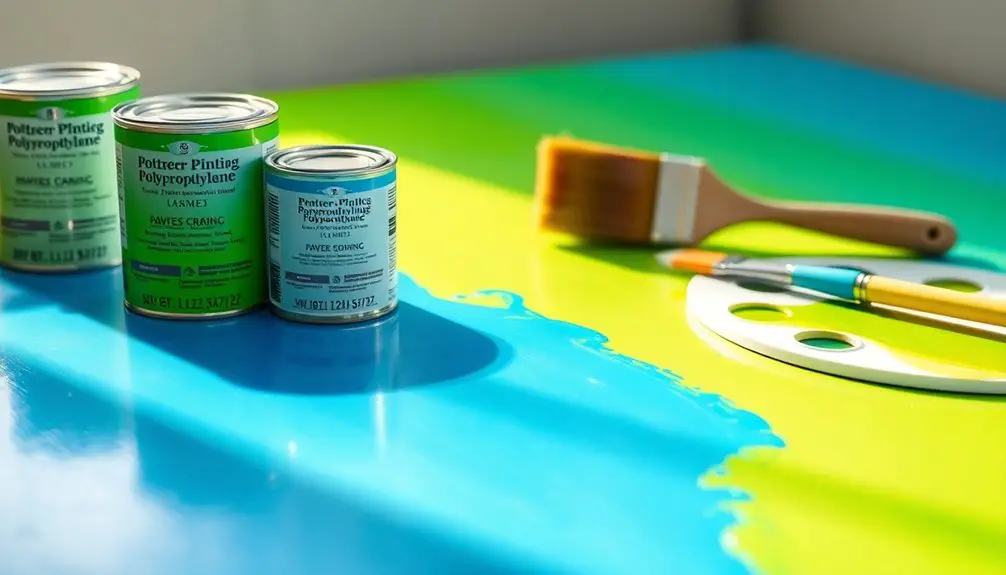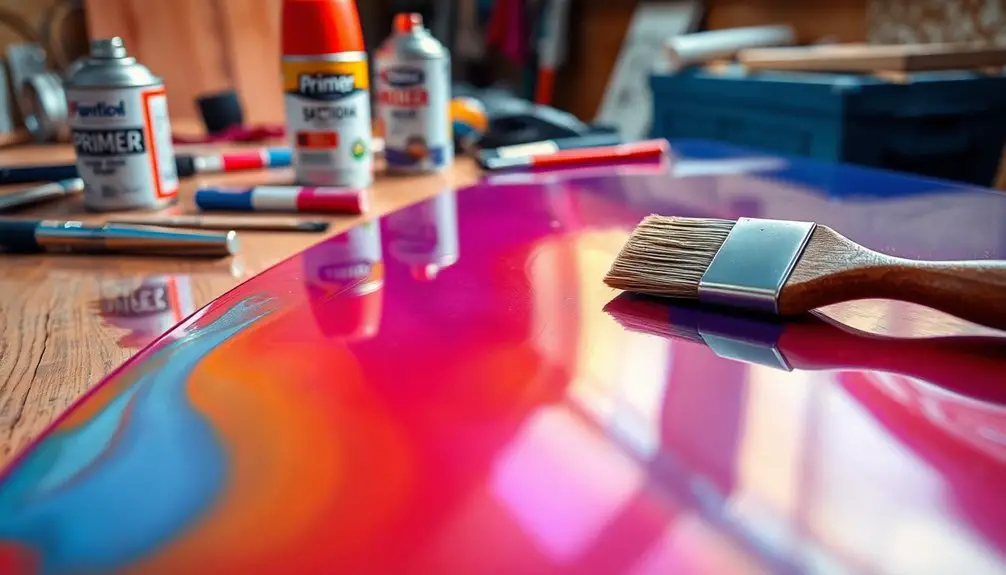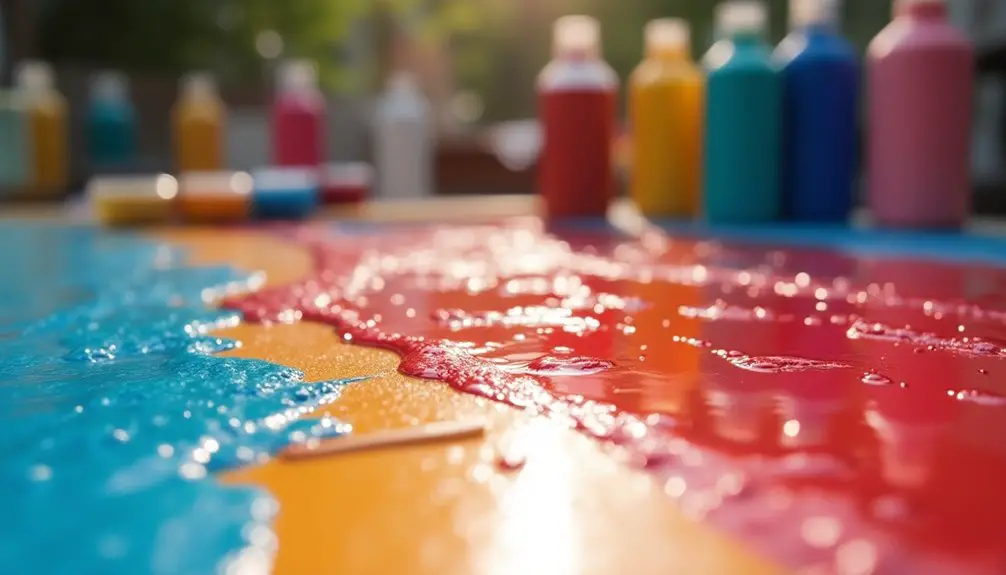To paint polypropylene for a lasting finish, start by cleaning with detergent and water to remove contaminants, then sand the surface with 320-400 grit sandpaper to enhance adhesion. Use Krylon Fusion spray paint for 2-3 light coats, allowing each coat to dry completely, and wet sand between coats for a smooth texture. After painting, let it cure for 7 days before applying a clear topcoat for added durability. Selecting the right paint and following these steps is crucial for a long-lasting result. Stick around to uncover more tips and tricks to elevate your painting project.
Key Takeaways
- Thoroughly clean and degrease the polypropylene surface to remove contaminants before painting.
- Lightly sand the surface with 320-400 grit sandpaper to enhance paint adhesion.
- Use Krylon Fusion for 2-3 light coats, allowing each to dry completely before applying the next.
- Wait 7 days after the final coat before applying clear topcoats for added durability.
- Consider using UV-resistant coatings to protect the finish from environmental damage.
Preparation Steps for Painting
Preparation is key to achieving a professional finish when painting plastics. First, you need to thoroughly clean your polypropylene surfaces with detergent and water. This removes any release agents and oils that could hinder paint adhesion.
Once the surface is clean, it's time to lightly sand it using 320-400 grit wet/dry sandpaper. This step enhances the texture and improves the bonding of your plastic paints.
After sanding, wipe the surface with lacquer thinners. This eliminates any residual grease, ensuring you have a clean painting surface. If you notice any dings, chips, or dents, fill them with a proprietary filler and allow it to harden.
Once it's set, wash the parts again to remove all residue.
To further ensure optimal adhesion, consider using a dedicated surface prep solution designed specifically for plastics. This additional step can make a significant difference in how well your paint adheres.
Using a plastic primer is also essential to improve adhesion between the paint and polypropylene surface.
Effective Painting Techniques
Once you've completed your surface preparation, it's time to focus on effective painting techniques that will ensure a flawless finish. Start by thoroughly cleaning and degreasing the surface to remove any contaminants. Use 320-400 grit wet/dry sandpaper to create a matte finish, enhancing paint adhesion. When looking for the best paint for your project, consider using a low-VOC option for a healthier environment with better indoor air quality. When applying paint, opt for Krylon Fusion, which is specifically designed for plastics. Apply 2-3 light coats, allowing each coat to dry completely before adding the next. Lightly wet sand between coats to eliminate imperfections and achieve a smooth finish.
Utilize masking tape to define your painting areas, which helps create clean lines and minimize overspray. If you want to improve adhesion further, consider flame treating the surface with a propane torch, but avoid direct contact afterward.
Finally, allow the paint to cure for the recommended 7 days before applying any clear topcoats like Lustercoat for added protection.
| Step | Action |
|---|---|
| Clean | Thoroughly clean and degrease |
| Apply Paint | Use 2-3 light coats of Krylon Fusion |
| Cure | Allow 7 days for maximum durability
Choosing the Right Paint

Choosing the right paint for your plastic project is crucial for achieving a durable and visually appealing finish. When it comes to polypropylene, you'll want to use specialty paints like Krylon Fusion, which are specifically designed for plastic surfaces. These paints offer superior adhesion without the need for primer, saving you time and effort. It's also essential to consider the surface preparation techniques and application methods, such as thinning acrylic paints with water, to ensure a smooth and even finish.
If you opt for acrylic or oil-based paints, be prepared to do some surface preparation to ensure they bond effectively to polypropylene. Always check the paint's compatibility with plastic and follow any specific product instructions regarding preparation and application techniques for the best results.
Color consistency is important, so try to choose paint from the same batch. To improve application, warm the paint cans in warm water for about 30 minutes before using them.
Lastly, consider the durability requirements of your project. Not all paints offer the same level of resistance to chipping, peeling, or UV fading, so it's essential to select a paint that aligns with your long-term expectations. Making the right choice here will help ensure that your finished project looks great and lasts longer.
Tips for a Lasting Finish
Achieving a lasting finish on your plastic project requires more than just selecting the right paint; it involves careful surface preparation and application techniques. Start by thoroughly cleaning and degreasing the polypropylene surface with detergent and water. Follow this with a wipe of lacquer thinners to eliminate any oils or contaminants that could hinder paint adhesion. Lightly sand the surface using 320-400 grit wet/dry sandpaper to enhance texture for better paint adherence. For a durable finish on polypropylene, applying a plastic-specific primer is essential to ensure strong bonding between the paint and surface.
| Step | Action | Purpose |
|---|---|---|
| Clean and Degrease | Use detergent and lacquer thinners | Remove contaminants |
| Sand Surface | Lightly sand with 320-400 grit | Improve adhesion |
| Apply Base Coat | Use 2-3 light coats of Krylon Fusion | Achieve a smooth, even gloss |
Wait a full 7-day curing period after the final coat before applying a clear Lustercoat for added durability. To further maximize longevity, consider using clear sealants and UV-resistant coatings. This will protect your painted surface from environmental damage and fading, ensuring that your painting plastics project looks great for years to come.
Common Challenges and Solutions

Painting plastics, especially polypropylene, comes with its share of challenges. To achieve the best results, you need to address several key issues during preparation. Here are three common challenges and their solutions:
- Low Surface Energy: Polypropylene's low surface energy makes it difficult for paint to adhere. Make sure you sand the surface with fine grit sandpaper (320-400 grit). This improves texture and increases adhesion.
- Release Agents: Molding release agents can significantly hinder paint adhesion. It's crucial to thoroughly clean the surface using a combination of detergent washes and flame treatment. This helps remove any contaminants that may affect the bonding process.
- Residual Contaminants: After sanding, ensure you have a clean surface by wiping it down with solvents like lacquer thinners. This eliminates any residual oils or contaminants that could compromise the paint's grip. When preparing the surface, also consider the potential risks of chemical leaching, as polypropylene is FDA-approved for microwaving.
Finally, conducting adhesion tests on your treated surfaces can help you identify the most effective preparation methods.
Frequently Asked Questions
What Kind of Paint Will Stick to Polypropylene?
You'll want to use Krylon Fusion paint for polypropylene, as it adheres well without primer. Additionally, consider using adhesion promoters to enhance stickiness, or choose acrylic paints with proper surface preparation for better results.
What Is the Best Way to Paint Polypropylene?
To paint polypropylene effectively, clean the surface, sand it lightly, and use a plastic-specific paint like Krylon Fusion. Apply multiple thin coats, allowing drying time in between, for a durable and smooth finish.
How Do You Paint Plastic so It Stays?
To paint plastic so it stays, clean the surface thoroughly, lightly sand it, and use paint designed for plastics. Apply multiple light coats, allowing drying time, and finish with a clear coat for extra protection.
What Kind of Paint Sticks to Polyethylene?
To paint polyethylene, use paints specifically designed for plastics, like Krylon Fusion. They adhere better without a primer. Remember to clean, sand, and apply light coats for a smooth, lasting finish.

